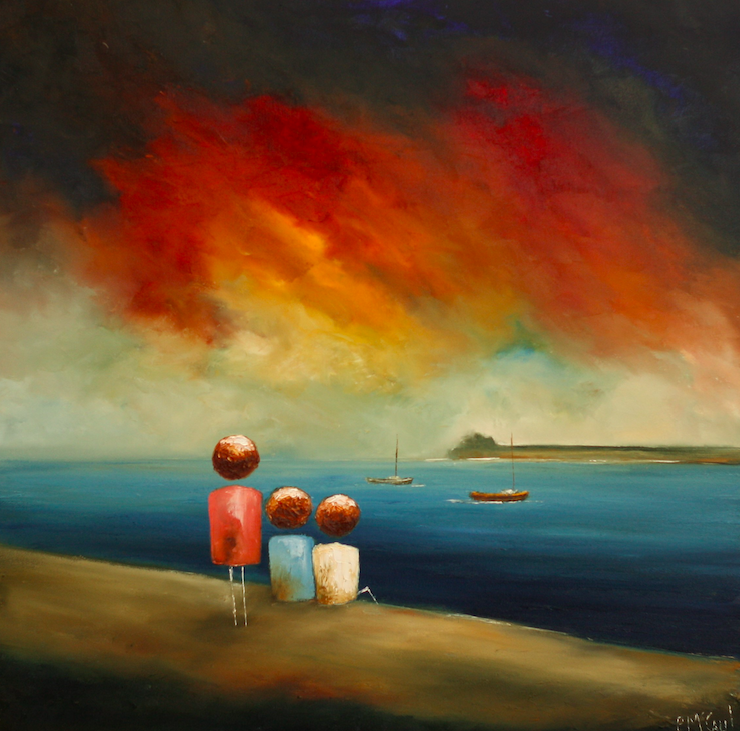Padraig McCaul is a Dublin-born artist whose work is steeped in the beauty and emotion of Ireland’s landscapes. Now living in Mullingar with his family, McCaul spent a transformative decade on Achill Island, where the rugged terrain and ever-changing skies of the Wild Atlantic Way became central to his artistic vision.

He describes his work as an effort to paint the feeling of a place rather than merely its physical appearance. His oils radiate the energy and spirit of the West of Ireland, drawing viewers into an emotional dialogue with the land and sea. McCaul’s style often features bright, open landscapes populated with charming cottages and old farmhouses, while his figurative pieces reflect personal connections and moments of quiet introspection.
McCaul has exhibited his works in London, Amsterdam, New York, and Australia, alongside regular shows across Ireland. His art invites viewers to experience not just a scene, but a story and a sense of belonging.
One of McCaul’s figurative works, Watching the Boats, offers a glimpse into his more personal artistic side. It depicts three young people sitting close together, gazing at boats in the distance. They might be siblings, close friends, or perhaps a mix of both. The relationships between the figures are left intentionally ambiguous, allowing viewers to interpret the scene through their own experiences.
The inspiration for this painting traces back to McCaul’s childhood in Dun Laoghaire, a coastal town near Dublin. He recalls spending countless hours on the pier—walking the family dogs or simply enjoying quiet moments with loved ones. These memories, full of closeness and reflection, shape the mood of Watching the Boats.
The painting embodies McCaul’s interest in human connection and shared experiences. He often refers to his figurative works as his “Family” paintings, celebrating the bonds that hold people together. In Watching the Boats, this connection is expressed not through action but through stillness. The figures are united by their shared focus on the boats, suggesting a moment of peace and harmony amid life’s motion.
As with his landscapes, McCaul employs a rich, textured style in his figurative paintings. Using palette knives, he layers oil paint to create depth and vibrancy. This approach lends a tactile quality to the work, making the texture as much a part of the experience as the colors and shapes.
In Watching the Boats, the colors are bold yet harmonious, capturing the coastal light and mood. The figures are outlined in soft strokes, blending into their environment rather than standing apart from it. This integration mirrors the interconnectedness of people and place—a theme that runs throughout McCaul’s art.
The texture is particularly insteresting in this painting. The palette knife work creates dynamic contrasts, with thicker strokes emphasizing the figures’ closeness while softer, blended areas evoke the serene, endless horizon. This balance between texture and fluidity is characteristic of McCaul’s style, whether he’s depicting cottages or people.
At its heart, Watching the Boats is about togetherness. The quiet companionship of the three figures speaks to the comfort of being with people who understand you, even in silence. This idea is central to McCaul’s figurative works, which often explore the bonds of family and friendship.
But there’s also an element of introspection. The figures’ focus on the boats suggests a moment of individual contemplation, even as they sit side by side. This duality—being part of a group while also lost in your own thoughts—feels universal. It’s a reminder that connection doesn’t always require words or action; sometimes, it’s enough just to betogether.
The setting reinforces this theme. The expanse of water and sky evokes both possibility and solitude. The boats, small and distant, are symbols of journeys yet to be taken or memories of journeys past. Whether the figures are reflecting on their own lives or simply enjoying the present moment, the scene captures a delicate balance between outward observation and inward thought.
What makes Watching the Boats so engaging is its ability to feel both deeply personal and broadly relatable. For McCaul, the painting is rooted in specific memories of Dun Laoghaire, but its themes resonate far beyond that. The bonds between the figures, the sense of peace in the moment, and the pull of the distant boats are experiences that many can connect with, regardless of where they’re from.
McCaul’s use of color, texture, and composition brings these themes to life with a warmth that feels inviting. By blending personal history with universal emotion, Watching the Boats reflects McCaul’s artistic philosophy: capturing not just a view but the soul of a moment.
In this work, as in all his art, McCaul invites viewers to pause, reflect, and feel. Whether you see yourself in the figures or find your thoughts drifting toward distant shores, the painting offers a space for connection—with others, with the landscape, and with your own memories.

